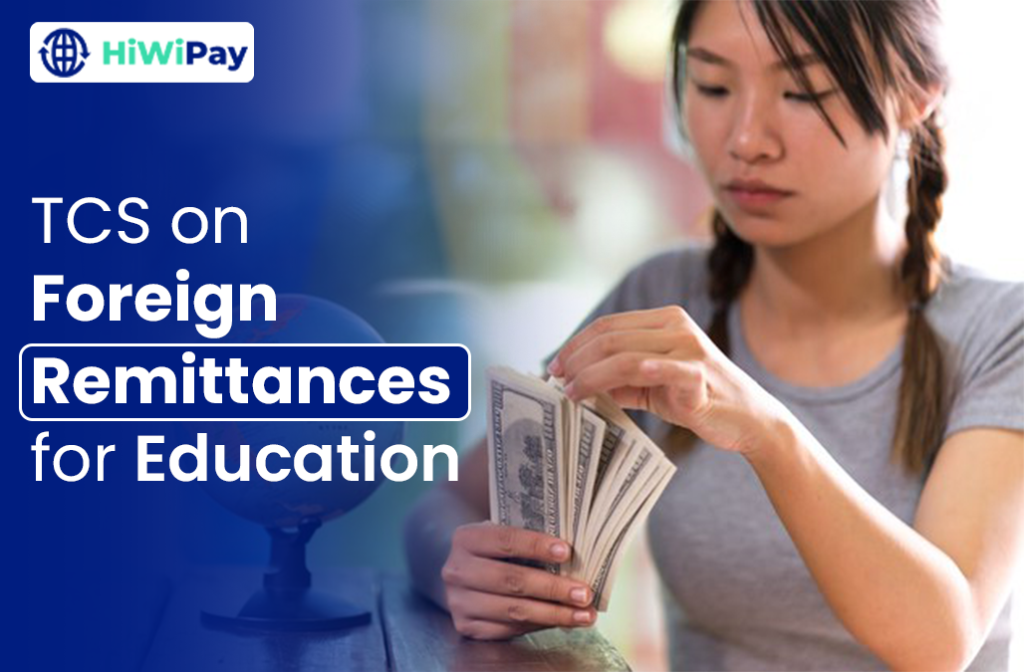TCS Rates on Education
Preparing to study abroad in another country is very exciting, but it also means you have to think a lot about your financial needs and the tax (TCS) involved.
The TCS rate for sending money abroad has changed, making it all the more vital for you to understand TCS. Under the Liberalised Remittance Scheme (LRS), the TCS rate has been increased from 5% to 20%, effective October 1, 2023. However, this new rate excludes sending money abroad from India for educational and medical purposes.
Here are the TCS rates for education remittances:
| Amount of Remittances | Purpose | TCS Rate |
| Below INR 7 Lakhs | Education | Nil |
| INR 7 Lakhs or more | Education Through Loan | 0.5% |
| INR 7 Lakhs or more | Education Not Through Loan | 5% |
- You don’t have to pay any TCS if the amount you are transferring is below INR 7 lakh remitted for educational purposes.
- If you are sending more money than INR 7 lakh, funded through a loan, the TCS rate is 0.5%.
- If you are sending more money than INR 7 lakh without the support of a loan, the TCS rate is 5%.
Let’s understand the application of the TCS rate through an example: Arjun is planning to study abroad, and the total educational expenses for the year amount to INR 10 lakh. He decided to fund it through a loan. For the first INR 7 lakh, no TCS will be applied, but for the remaining INR 3 lakh 0.5% TCS (INR 1500) will be applied. If he had decided not to fund it through a loan, then for the remaining INR 3 lakh, 5% TCS (INR 15,000) would have applied.
If you want to send money abroad quickly (within 24 hours) without worrying about TCS, let HiWiPay be your support system. HiWiPay offers transparent fee structures and will make sending money overseas so convenient—like sending a text. Visit our website or download our app today!
As an Indian student studying abroad, educational expenses are not the only expenses you have, so if you want to send money overseas for an expense that is not directly related to education, such as travel, accommodation, personal expenses, etc., then the TCS rate will be higher.
Here is the TCS rate for overseas outward remittances:
| Amount of Remittances | TCS Rate |
| Below INR 7 Lakhs | Nil |
| INR 7 Lakhs or more | 20% |
With such high TCS rates, you deserve a low markup fee. HiWiPay, your support system, offers competitive rates (1-2% markup) while ensuring compliance with regulations. They even provide flexibility in payment methods! What more could you want? Visit our website or download our app today!
Certain exceptions on TCS
There are certain exceptions of TCS if you are sending money overseas for education-related transactions, such as:
- Scholarships: TCS does not apply to scholarships received from recognised educational institutions abroad.
- Low Annual Income: TCS does not apply to an annual income of INR 2 lakh or below.
- Equivalent TDS Deposit: TCS may not be applied on the same remittance for which you have already deposited the equivalent amount of TDS (Tax Deducted at Source) in your NRE account.
Impact of TCS on Educational Expenses
Understanding the impact of TCS helps you make informed decisions and plan your finances effectively while pursuing education abroad, so here is the impact of TCS on educational expenses:
- Increased Overall Costs: TCS adds an additional financial burden to your educational expenses. When remitting funds abroad, the TCS amount is deducted upfront, affecting the total amount available for your education.
- Budget Adjustments: As a student, you need to adjust their budget to account for the TCS component. It is essential to plan your finances carefully to ensure that you have sufficient funds for tuition fees, accommodation, and other expenses.
- Immediate Cash Outflow: TCS results in immediate cash outflow at the time of remittance, so you must prepare for this deduction and plan accordingly.
- Tax Credit Planning: While TCS is collected upfront, you can claim a tax credit for the TCS amount paid when filing your income tax return. Proper documentation is crucial here.
- Educational Choices: TCS may influence your choice of educational institutions or countries. Consider countries with lower TCS rates or exemptions for educational remittances.
- Need for More Funds: Due to TCS, you may need to remit a higher amount to cover the actual educational expenses. Ensure you have a buffer to account for TCS deductions.
Inclusion of Living Expenses
Living expenses are essential for maintaining a comfortable lifestyle during your educational journey. So, you might wonder if you will have to pay TCS when sending money overseas. Well, the answer is yes. TCS will be applicable to remittances for living expenses. The TCS rate here will be the same as for educational purposes. Once the amount crosses the threshold of INR 7 lakh in a financial year, 0.5% TCS will apply if the money is funded through a loan; otherwise, 5% TCS will apply.
Here are some more things included in remittances for education:
- Remittance for the purchase of tickets by the person studying abroad for commuting between India and the foreign location.
- Tuition and other costs payable to the educational institute.
- Other daily expenditures associated with studying abroad, such as food, accommodation, local transport, health services, etc.
Do you want to save money on your money transfer overseas? With HiWiPay’s lowest markup fee imaginable, you can, that too from ANYWHERE, ANYTIME! Send money abroad within 24 hours with complete peace of mind! The best part? You only need to complete the KYC ONCE and digitally submit the A2 Form. No need to fill everything again and again!
FAQS on TCS On Foreign Remittances For Education
Is TCS applicable on foreign remittance for education?
Yes, TCS is applicable on foreign remittance for education under LRS. Here are the TCS rates:
| Amount of Remittances | Purpose | TCS Rate |
| Below INR 7 Lakhs | Education | Nil |
| INR 7 Lakhs or more | Education Through Loan | 0.5% |
| INR 7 Lakhs or more | Education Not Through Loan | 5% |
How do I claim TCS on foreign remittances?
You can only claim TCS on foreign remittances if you have paid more TCS than your actual tax liability.
Follow these steps to claim TCS on foreign remittance:
- Collect the TCS certificate (Form 27D) provided by the collector.
- Before filing your ITR, verify Form 26AS, which is a consolidated tax statement that provides details of the taxes deducted on your behalf.
- File your ITR for the year.
- Claim TCS refund in ITR by filling out the relevant sections of the ITR form and providing supporting documents.
How do I avoid 20% TCS on foreign remittance?
Avoid 20% TCS on foreign remittance for education expenses with the following ways:
- Remit money below INR 7 lakh in a financial year.
- If you are sending money for education purposes, you won’t have to pay much TCS. The TCS rate with a loan is 0.5%, and without a loan, it is 5%.
- If you are sending money for medical purposes, you won’t have to pay much TCS. The TCS rate for the amount remitted above INR 7 lakh is 5%.
- Use a credit card to send money. Credit cards are exempt from TCS as they are not considered under LRS.
- Use a non-resident Indian (NRI) account.
- Pay using a zero forex international debit card.
- Paying using an online remittance company like HiWiPay.
How much foreign income is tax free in India?
As an Indian resident, if you are earning from another country and you have paid tax for the income earned in the source country, then you can claim credit in India for this. As per the income tax slab for the financial year 2023-2024, income up to INR 3,00,000 is tax-free.
How much money can you send overseas under LRS in a year?
As per the Liberalised Remittance Scheme (LRS), you can send up to USD 250,000 (INR 20,682,750) in a year. To send money for more than this, you must contact the RBI for approval.
Which education expenses will qualify for a lower TCS rate?
In India, certain education expenses can qualify for a lower Tax Collected at Source (TCS) rate, such as:
- If you take an education loan from a financial institution, the TCS rate is 0.5%.
- TCS rate is low for sending money abroad for educational expenses (without a loan: 5% TCS) and medical expenses (5% TCS).
- If you receive scholarships or grants for education, the TCS rate on such amounts might be reduced or eliminated.
- TCS does not apply to an annual income of INR 2 lakh or below
- TCS may not be applied to a remittance for which you have previously deposited the equivalent amount of TDS (Tax Deducted at Source) into your NRE account.
Documents you need to send money for your child’s overseas education
The following documents are required to send money for your child’s overseas education:
- University acceptance letter mentioning the amount to be transferred
- Valid Indian passport of the student
- Valid Indian ID proof of the sender (PAN card, Aadhar Card or driving license)
- PAN Card of the sender
- Duly Filled A2 Form cum Declaration
- KYC Documents like a passport or Aadhar Card
NOTE: The exact document requirements may vary depending on the bank or service provider you choose for the transfer. So, do check with them before initiating the transfer.
References:
Acharya , Mayashree. “Taxation of Foreign Source Income.” Cleartax, 9 May 2023, cleartax.in/s/taxation-of-foreign-source-income. Accessed 5 Apr. 2024.
CA Dr. Dilip Satbhai. “New TCS Rule from 1st October 2023: Tips to Reduce TCS on Foreign Trip.” TaxGuru, 26 Sept. 2023, taxguru.in/income-tax/tcs-rule-1st-october-2023-tips-reduce-tcs-foreign-trip.html. Accessed 5 Apr. 2024.
Chopra, CA Mamta. “New 20% TCS on Foreign Remittance from 01.10.2023 Simplified.” TaxGuru, 30 Sept. 2023, taxguru.in/income-tax/new-20-percent-tcs-foreign-remittance-oct-2023-simplified.html#:~:text=As%20of%20this%20date%2C%20all%20overseas%20outward%20remittances%2C. Accessed 5 Apr. 2024.
Niyo, Team. “Sending Money Abroad for Education – Impact of TCS and Tips to Reduce Impact.” Niyo, 14 Nov. 2023, goniyo.com/blog/sending-money-abroad-for-education-tips-to-reduce-burden/. Accessed 5 Apr. 2024.
Ray, Anulekha. “Sending Money Abroad for Education? Pay 20% TCS from July 1 If You Don’t Do This.” The Economic Times, 16 June 2023, economictimes.indiatimes.com/wealth/tax/sending-money-abroad-for-education-pay-20-tcs-from-july-1-if-you-dont-do-this/articleshow/100671265.cms?from=mdr. Accessed 5 Apr. 2024.
—. “Sending Money Abroad for Education? Watch out for These Errors to Avoid 20% TCS.” The Economic Times, 8 July 2023, economictimes.indiatimes.com/wealth/tax/tcs-on-foreign-remittances-sending-money-abroad-for-education-watch-out-for-these-steps-to-avoid-20-tcs/printarticle/101590487.cms. Accessed 5 Apr. 2024.
“Tax on Foreign Remittance for Education in 2024.” WeMakeScholars, 28 Feb. 2024, www.wemakescholars.com/blog/new-tax-on-foreign-remittance-all-you-need-to-know. Accessed 5 Apr. 2024.
“What Is Liberalised Remittance Scheme (LRS)?” Cleartax, 18 May 2023, cleartax.in/s/what-is-liberalised-remittance-scheme. Accessed 5 Apr. 2024.








